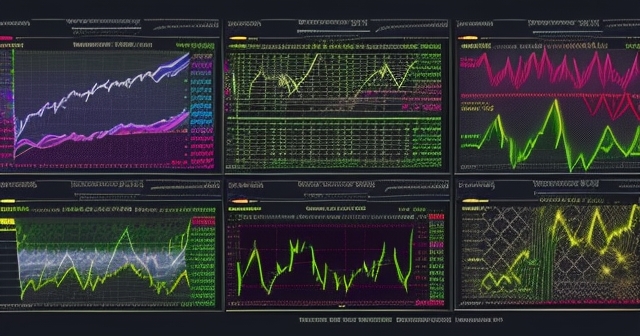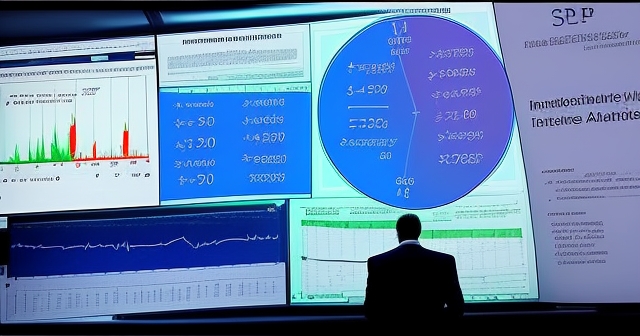
S&P 500 Futures Forecast: What’s Next for Investors in Today’s Market Dynamics?
Table of Contents
ToggleNavigating the Currents: What the Latest Signals Mean for S&P 500 Futures
Welcome to our exploration of the forces shaping the markets, specifically focusing on the S&P 500 futures. Understanding these instruments, which essentially represent a contract to buy or sell the S&P 500 Index at a future date for a specific price, requires dissecting a multitude of global economic and political factors. Today, we’re going to break down some of the key drivers currently influencing market sentiment and the potential path forward for these crucial futures contracts. Think of the market as a vast ocean, and S&P 500 futures as one of its most significant vessels. To forecast its journey, we must analyze the winds of trade, the currents of economic data, and the hidden rocks of policy risks. Are you ready to dive in?

To better understand the current landscape of S&P 500 futures, consider the following key points:
- The influence of trade discussions, particularly between the U.S. and China.
- The impact of inflation data on monetary policy and market conditions.
- The relationship between bond yields and equity performance.
Trade Talks in the Spotlight: The Primary Wind Direction
Right now, one of the most significant factors commanding investor attention is the ongoing series of U.S.-China trade discussions. As of our analysis, markets are demonstrating a cautious posture, with S&P 500 futures showing only marginal changes following a relatively quiet session on Wall Street. This muted reaction isn’t indifference; it’s a direct reflection of investors waiting with bated breath for clarity from these high-stakes negotiations. When officials from the world’s two largest economies sit down, their dialogue becomes the primary ‘wind’ influencing market direction.

The latest round of talks, reportedly taking place in London, centers on thorny issues that have defined the trade relationship for years. We’re talking about subjects like critical minerals, which are essential components in everything from smartphones to defense technology, and the ever-present specter of tariff easing versus potential new impositions. Remember, these aren’t just academic discussions. The outcomes here can directly impact global supply chains, corporate profitability, and ultimately, the perceived value of companies listed on the S&P 500 Index.
Why such intense focus? Because past trade tensions have proven to be powerful catalysts for market volatility. Any sign of progress can fuel optimism, while setbacks can trigger significant sell-offs. Therefore, monitoring the tone and substance of these trade discussions is not just important; it’s arguably the single most critical near-term activity for anyone trading or tracking S&P 500 futures.
The Tariff Tightrope: Balancing Hope and Historical Lessons
We’ve seen this play before, haven’t we? The narrative around U.S.-China trade is a complex tapestry woven with threads of negotiation, imposition, and sometimes, reversal. A recent development that provided a degree of positive backdrop was the temporary agreement to slash duties that had been reached last month. This was widely interpreted as a significant, albeit temporary, breakthrough, especially considering the initial, much steeper tariff plans previously floated. Such agreements can provide a temporary lift to market sentiment, easing fears about escalating trade wars crippling global growth.
However, experienced market participants remain keenly aware of the historical context. We recall instances where trade war fears, often stemming from tariff announcements or escalations, directly correlated with notable market downturns. For instance, one dataset we reviewed showed a significant single-day drop in S&P 500 futures during a period when tariffs were heavily in the news, with related headlines explicitly linking the decline to trade war fears under the previous administration. This serves as a stark reminder that while temporary truces are welcome, the underlying tensions and the potential for reciprocal actions introducing volatility remain. Investors are, in a sense, walking a tightrope, balancing cautious optimism about current dialogue against the historical reality of how quickly tariff policies can shift and impact asset prices.
So, as we watch the trade talks unfold, we aren’t just looking for headlines; we’re assessing the probability of lasting change versus temporary appeasement. The market seems somewhat “jaded,” as some observers put it, regarding rapid-fire policy changes, suggesting that only concrete, sustained progress on tariff reduction is likely to provide a durable boost to S&P 500 futures and the broader equity market.
Economic Data on the Horizon: The Inflation Current
Beyond the realm of geopolitical trade, the domestic economic landscape continues to be a powerful driver for market expectations. This week, investors are particularly focused on a series of crucial U.S. economic data releases. These reports provide vital clues about the health of the economy and, more specifically, the trajectory of inflation. The two key indicators on everyone’s radar are the Consumer Price Index (CPI) and the Producer Price Index (PPI), slated for release later in the week.

Why are CPI and PPI so important for S&P 500 futures? Because they directly influence expectations for the Federal Reserve’s monetary policy decisions, particularly regarding interest rates. Higher-than-anticipated inflation data increases the likelihood that the Fed might need to maintain higher interest rates for longer, or even consider further hikes (though current forecasts lean towards cuts). Conversely, cooler inflation data could pave the way for earlier or more significant rate cuts. Interest rates, in turn, impact everything from borrowing costs for companies to the discount rate used in valuing future corporate earnings. Changes in interest rate expectations can therefore significantly alter the perceived value of the companies that make up the S&P 500 Index, flowing directly into the pricing of its futures contracts.
Remember the hotter-than-anticipated PPI data from earlier in the year mentioned in one of the data excerpts? That served as a reminder that inflationary pressures can linger, potentially complicating the Fed’s path. While some analysts, like those at Wells Fargo, forecast potential Fed rate cuts in 2025, even these forecasts are influenced by factors like assessing the impact of tariffs on inflation – highlighting the interconnectedness of the factors we are discussing. Watching how the market reacts to the upcoming CPI and PPI numbers will give us crucial insight into the prevailing sentiment regarding the inflation current and its potential impact on the Fed’s next move.
The Fed’s Influence: Steering Through Monetary Policy
As we’ve just discussed, the Federal Reserve’s monetary policy is inextricably linked to the inflation picture. The market’s anticipation of the Fed’s next move, particularly regarding interest rate adjustments, acts as a powerful steering mechanism for asset prices, including S&P 500 futures. While the data indicates some forecasts for potential rate cuts in 2025, these are not guaranteed and are highly contingent on the economic data that unfolds.
Consider the relationship between interest rates and equity valuations. Generally, lower interest rates make borrowing cheaper for companies, potentially boosting their investments and profits. Lower rates also make equities more attractive compared to fixed-income investments like bonds, which tend to offer lower returns in a low-rate environment. Conversely, higher interest rates can increase borrowing costs, potentially dampening corporate expansion, and make bonds more competitive as an investment option, drawing capital away from stocks.
Therefore, every piece of economic data, every statement from a Fed official, is scrutinized for clues about the likely path of monetary policy. If upcoming inflation data comes in higher than expected, it could push back expectations for rate cuts, potentially leading to a downward adjustment in S&P 500 futures as investors price in a less favorable interest rate environment. Conversely, weak economic data or cooling inflation could accelerate rate cut expectations, potentially providing a tailwind for equities. Understanding this dynamic is fundamental to interpreting the market’s reaction to economic news.
Bond Yields and Equity Rebounds: A Delicate Balance
Another crucial dynamic at play involves the relationship between bond yields and the equity market. Bond yields represent the return an investor receives on a bond. When yields rise, bonds become relatively more attractive compared to stocks, especially for investors seeking stable income. Higher bond yields also impact the cost of capital for businesses and influence valuation models used to assess stock prices.

According to analysis from firms like JPMorgan, advancing bond yields could potentially “arrest” or limit the rebound we’ve seen in the equity market. Why is this the case? As bond yields increase, they offer a higher ‘risk-free’ rate of return (assuming government bonds). This increases the opportunity cost of investing in riskier assets like stocks. Investors might decide that the return offered by bonds is now sufficient, reducing demand for equities. Furthermore, higher yields translate to higher borrowing costs for companies, potentially squeezing profit margins or slowing growth, which can negatively impact stock valuations.
So, while market participants often focus solely on stock indices, keeping an eye on the bond market, particularly benchmark government bond yields, is essential. A sustained rise in yields could act as a significant headwind, potentially limiting upside potential or even contributing to declines in S&P 500 futures, regardless of positive news elsewhere. It’s a delicate balance, where the attractiveness of different asset classes is constantly being weighed by investors.
Policy Risks Beyond Trade: The Section 899 Concern
While trade and monetary policy dominate headlines, other legislative and regulatory developments can also introduce significant uncertainty and risk into the market. One example highlighted in the provided data is the concern surrounding a provision (Section 899) within a proposed U.S. tax bill, reportedly dubbed the “One Big Beautiful Bill Act.”

What is this provision, and why is it causing jitters? According to the information, fund managers are expressing concern that Section 899 could potentially lead foreign investors to pull out of U.S. markets. Foreign investment is a substantial component of the capital flowing into U.S. equities and bonds, providing liquidity and supporting asset prices. Any policy that is perceived as making U.S. markets less attractive or more burdensome for international investors could trigger significant outflows, putting downward pressure on stock prices and, by extension, S&P 500 futures.
Lobbying efforts are reportedly underway to amend this provision, indicating the seriousness with which the financial industry views this potential risk. This serves as a powerful reminder that market analysis isn’t just about economic indicators and corporate earnings; it also requires vigilance regarding legislative and regulatory changes in Washington. Such policy-driven risks, while perhaps less frequently discussed than inflation or trade, have the potential to cause swift and significant market reactions if they materialize.
If you are looking to diversify your investment exposure or explore different asset classes affected by global policy shifts, understanding the implications of these factors is key. The interconnectedness of global finance means that policy changes in one major market can have ripple effects elsewhere.
Seasonality and Market Momentum: Riding the Waves
In addition to fundamental economic drivers and policy factors, market technicians and strategists often consider historical patterns, including seasonal trends. These trends represent tendencies for market behavior during specific times of the year, often influenced by factors like investment cycles, holidays, or typical trading volumes.
According to some market observers, like those at Raymond James, the current period may point towards a potential wane in market momentum, sometimes referred to as the “summer doldrums.” This historical tendency suggests that trading activity might slow down, and significant price movements could become less frequent as market participants take holidays and major corporate/economic news might thin out.
While seasonal trends should never be the sole basis for investment decisions, they can provide a useful context for understanding market behavior. If a period is historically associated with reduced momentum, it might suggest that strong rallies or sharp declines are less likely unless driven by a major, unforeseen catalyst. For traders of S&P 500 futures, being aware of potential seasonal shifts can help in adjusting strategies, perhaps by reducing position sizes or focusing on shorter-term movements if volume and volatility are expected to decrease.
It’s important to remember that seasonality is just a historical tendency, not a guarantee. Major news events, like breakthroughs or breakdowns in trade talks, or unexpected inflation data, can easily override typical seasonal patterns. Nevertheless, incorporating this perspective can add another layer to your market analysis.
Technical Perspectives: Reading the Charts
Beyond fundamental and seasonal analysis, many traders rely heavily on technical analysis to inform their decisions on S&P 500 futures. Technical analysis involves studying historical price and volume data to identify patterns and predict future price movements. While the provided data snippets didn’t include extensive chart patterns, they did offer specific technical details like real-time prices for E-mini S&P 500 futures contracts (e.g., the Mar 2025 contract trading around 6080.00, and the June 2025 contract showing specific past performance figures).

These price points and performance figures are the raw material for technical analysts. They look at support and resistance levels, moving averages, trend lines, and various indicators (like RSI, MACD, etc.) to gauge market strength, identify potential turning points, and set entry and exit points for trades. For instance, knowing that a particular futures contract is trading near a significant past high or low can be a key piece of information for a technical trader.
While a full technical breakdown is beyond the scope here, recognizing that these data points exist and are crucial for a segment of the market is important. Technical analysis provides a different lens through which to view the S&P 500 futures outlook, focusing purely on the market’s own action rather than external factors. Combining fundamental understanding (like trade talks and inflation) with technical analysis often provides a more robust trading framework.
Whether you are a new investor just learning the ropes or an experienced trader refining your strategy, developing the ability to look at the market from multiple perspectives – fundamental, policy-driven, seasonal, and technical – is invaluable. It allows you to build a more complete picture and anticipate potential shifts in market direction.
If you’re beginning your journey in trading futures or other global financial instruments, selecting the right platform is a fundamental step. In choosing a trading platform, the flexibility and technological edge of Moneta Markets are worth noting. It supports mainstream platforms like MT4, MT5, and Pro Trader, combined with high-speed execution and low spread settings, offering a solid trading experience for various asset classes, potentially including index futures or related CFDs depending on regional offerings.
The Interconnected Web: How Factors Converge
It’s crucial to understand that the factors we’ve discussed – trade talks, tariffs, inflation data, Fed policy, bond yields, tax risks, and seasonality – don’t operate in isolation. They are part of an interconnected global financial web, where developments in one area can quickly impact others, creating complex feedback loops.
For example, a positive breakthrough in trade talks could boost investor sentiment, potentially leading to increased demand for equities and pushing S&P 500 futures higher. This increased optimism might also reduce safe-haven demand for bonds, causing yields to rise. However, rising yields, as discussed, could then become a headwind for stocks, partially offsetting the positive impact of the trade news. Simultaneously, if trade tariffs were to significantly increase the cost of imported goods, this could directly fuel inflation, putting pressure on the Federal Reserve to maintain a hawkish stance, which would further support higher bond yields and weigh on equities.
This constant interplay makes forecasting S&P 500 futures a dynamic and challenging exercise. There is no single indicator or event that dictates the market’s direction. Instead, we must continuously analyze the collective impact of these various forces, assessing their relative strength and potential for surprises.
Understanding these complex relationships is a continuous learning process. It requires staying informed, being adaptable, and refining your analysis based on new information as it becomes available. As investors, our goal isn’t necessarily to predict the future with perfect accuracy, but rather to understand the key drivers of market movement and position ourselves accordingly, managing risk along the way.
Crafting Your Outlook: Balancing Optimism and Caution
So, based on the signals we’ve analyzed, what might the immediate future hold for S&P 500 futures? The picture remains one of balance between potential upside catalysts and lingering risks. On the one hand, renewed trade dialogue offers a glimmer of hope for resolving long-standing tensions and potentially removing a significant overhang of uncertainty. The recent temporary tariff reduction agreement provides a positive precedent.
On the other hand, the outcome of the trade talks is far from assured, and the potential for renewed tariff threats remains a real risk, given the historical context. Furthermore, upcoming inflation data could introduce volatility, depending on whether it suggests inflationary pressures are easing or persisting. The potential for rising bond yields to temper the equity rebound is another factor warranting close attention. And we must not forget potential policy risks, like the Section 899 tax provision, which could impact foreign investment flows.
For you, as an investor or trader, this means maintaining a stance of cautious optimism. While the current muted state of S&P 500 futures suggests a waiting game, the factors we’ve discussed are powerful catalysts that could trigger significant movement in either direction this week. Staying informed about the progress of trade talks, the results of the CPI and PPI releases, and monitoring bond yields will be crucial for navigating the market in the days ahead.
Remember, successful trading and investing are less about predicting the future and more about understanding the present dynamics and potential future scenarios. By dissecting the key drivers and risks, we can better anticipate market reactions and make more informed decisions about our positions in S&P 500 futures or related instruments. This journey of continuous learning and adaptation is fundamental to long-term success in the markets.
Navigating global markets requires access to a range of instruments and robust trading technology. If you are looking for a brokerage that offers wide market access and strong regulatory oversight, Moneta Markets is regulated by authorities like FSCA, ASIC, and FSA. They provide services like segregated client funds, free VPS, and 24/7 support, which are important considerations for traders focused on security and reliability while accessing various global financial markets, potentially including indices and other CFDs.
| Indicator | Current Status | Impact on S&P 500 Futures |
|---|---|---|
| Trade Discussions | Ongoing | High |
| Inflation Data (CPI & PPI) | Pending Release | Moderate to High |
| Bond Yields | Increasing | Negative Pressure |
Additionally, consider these important relationships impacting S&P 500 futures:
- The flow of foreign investments can significantly influence market dynamics.
- Upcoming economic indicators will shape expectations around monetary policy.
- Market sentiment can change rapidly based on new information or policy announcements.
s&p 500 futures forecastFAQ
Q:What are S&P 500 futures?
A:S&P 500 futures are contracts to buy or sell the S&P 500 Index at a predetermined future date and price, allowing investors to hedge or speculate on market movements.
Q:Why are trade discussions important for S&P 500 futures?
A:Trade discussions between major economies like the U.S. and China can significantly affect investor sentiment and market volatility, directly impacting futures pricing.
Q:How do interest rates influence S&P 500 futures?
A:Interest rates impact borrowing costs and investment attractiveness; rising rates can lead to lower futures prices, while falling rates may support higher prices.
You may also like
Calendar
| 一 | 二 | 三 | 四 | 五 | 六 | 日 |
|---|---|---|---|---|---|---|
| 1 | 2 | 3 | 4 | 5 | 6 | 7 |
| 8 | 9 | 10 | 11 | 12 | 13 | 14 |
| 15 | 16 | 17 | 18 | 19 | 20 | 21 |
| 22 | 23 | 24 | 25 | 26 | 27 | 28 |
| 29 | 30 | 31 | ||||
發佈留言
很抱歉,必須登入網站才能發佈留言。